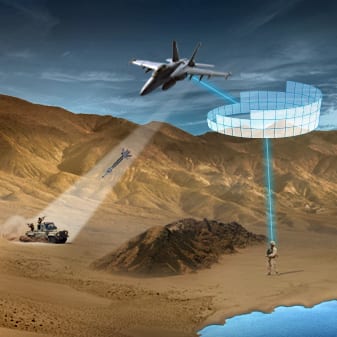
The Viasat BATS-D handheld radio is to aid aircraft and ground forces in Close Air Support and other missions. Photo: Viasat
California-based Viasat has received a $90 million Indefinite-Delivery/Indefinite-Quantity (ID/IQ) contract from United States Air Force (USAF) Life Cycle Management Center at Wright Patterson AFB, Ohio to provide USAF special forces with the company’s Battlefield Awareness Targeting System—Dismounted (BATS-D) handheld Link 16 radios, also known as AN/PRC-161 radios.
The company said that BATS-D “is the world’s first and only handheld Link 16 radio” and “bridges a critical gap between air and ground forces by providing warfighters at the tactical edge with real-time, secure, reliable access to integrated air and ground information for improved situational awareness and enhanced close air support communications.”
Ken Peterman, president of Viasat Government Systems, said U.S. forces have received 2,500 BATS-D radios thus far and that “we continue to see strong demand for its use across multiple military branches, and among coalition partners as it has the proven ability to significantly enhance situational awareness, improve mission coordination and accelerate decision timelines in a multi-domain battlespace.”
Improved close air support is one of the areas that defense contractors are examining, as the Pentagon moves to reduce situational awareness information gaps among aircraft and ground forces.
The Viasat contract comes as congressional defense authorizers are pushing for a ramp up of the U.S. Air force Light Attack Aircraft program to support special operations forces on the ground.
The Air Force plans to conduct experiments for that program with the Textron Aviation AT-6 Wolverine and the Sierra Nevada Corporation (SNC)/Embraer A-29 Super Tucano to ensure that the planes’ avionics networks are compatible with those of other military services and national defense forces.
BATS-D “is designed for the dismounted warfighter” and “is fully interoperable with any U.S. or coalition aircraft operating on the Link 16 network, including the [Lockheed Martin] F-35, A-29, [Boeing] AV-8B, [Boeing] AH-64E, [Lockheed Martin] F-16, [Boeing] F-15, [Boeing] F/A-18, and many others,” Peterman wrote in an email to Avionics International.
“BATS-D enables the dismounted warfighter to digitally connect with all the platforms mentioned above to provide precise position location on the ground and enables the dismount to see the location of all the air participants to increase lethality and reduce the potential for fratricide,” he wrote.
Viasat has been involved in other situational awareness enhancement efforts, including the provision of wideband satellite communications capability for some Bell-Boeing V-22 tiltrotor aircraft to allow them to update mission plans in-flight based on changing threat conditions. Viasat has also installed satcom on hundreds of military aircraft, including Boeing C-17 transports, Lockheed Martin C-130 transports and AC-130 gunships, and a number of command and control/intelligence, surveillance and reconnaissance aircraft, such as the Boeing RC-135 Rivet Joint aircraft.
“Viasat’s BATS-D is capable of interfacing with any aircraft that is capable of Link 16,” Peterman wrote in his email. “The initial use case is to support digitally-aided Close Air Support (DaCAS) but it also expands to support artillery support, command and control, and general situational awareness for the ground forces. This award enables the U.S. Air Force to acquire the general purpose forces configuration of the AN/PRC-161 to address USAF requirements for digitally-aided Close Air Support and other applications. Subject to concurrence with the USAF program office, other services could use this ID/IQ as well. The BATS-D is an outstanding solution for any dismounted or ground warfighter that needs access to the Common Operational Picture and assured connectivity in a contested environment.”